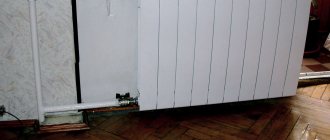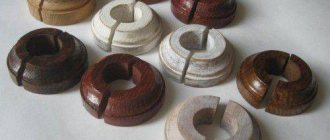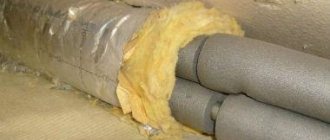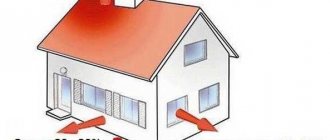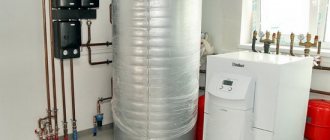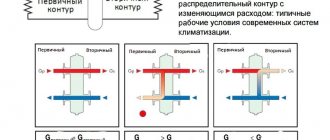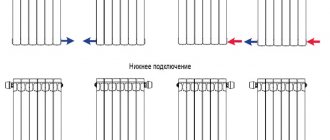Automated calculation of the volume of insulation of round surfaces, such as pipes, air ducts and pipelines, by outer diameter. The calculator calculates the volume of insulation in cubic meters, as well as the insulation area in square meters. According to the technical part of the collection FER26:2. Rules for calculating the volume of work 2.1 The volume of insulation “in use” (Oi) m3 per 1 m of length of pipelines or cylindrical equipment is calculated using the formula: Oi = 3.14 × (D + T) × T, where T is the thickness of the insulating layer, m; D - outer diameter of the pipeline or equipment, m.2.2. Length of insulated pipelines, as well as equipment of cylindrical and rectangular sections, etc.
determined along the center line for each section, and fittings and flanges, fittings, etc. are not excluded from the length.2.3. The perimeter of a polygonal and similar section is determined as the arithmetic mean of the perimeters of the internal and external surfaces of the insulation.2.4. The volume of insulation of individual places near instrumentation and fittings, as well as near all kinds of hatches, fittings, openings on equipment is taken into account in prices, while the length of insulated pipelines is measured without deducting the indicated places.
To get the result, enter values in the form fields.
Did you like the calculator? Share with your friends
Find the angle ABC of an isosceles trapezoid ABCD if the diagonal AC forms with the base AD and * Trapezium Mathematics / Russian language 9th grade.
Insulation materials
The range of means for installing insulation is very extensive.
Their difference lies both in the method of application on the surface and in the thickness of the thermal insulation layer. The application features of each type are taken into account by calculators for calculating pipeline insulation. The use of various bitumen-based materials with the use of additional reinforcing products, such as fiberglass or fiberglass, is still relevant. Polymer-bitumen compositions are more economical and durable. They allow for quick installation and the quality of the coating is durable and effective. The material, called polyurethane foam, is reliable and durable, which allows its use for both channel and non-channel methods of laying highways. Liquid polyurethane foam is also used, applied to the surface during installation, as well as other materials:
- polyethylene as a multilayer shell, applied in industrial production for waterproofing;
- glass wool of various thicknesses, an effective insulation due to its low cost with sufficient strength;
- For heating mains, mineral wool of the calculated thickness is effectively used to insulate pipes of various diameters.
Installation of insulation
Calculation of the amount of insulation largely depends on the method of its application. It depends on the place of application - for the internal or external insulating layer. You can do it yourself or use a calculator program to calculate the thermal insulation of pipelines. Coating on the outer surface is used for water pipelines for hot water supply at high temperatures to protect it from corrosion. Calculation with this method comes down to determining the area of the outer surface of the water supply system to determine the need per linear meter of pipe.
Internal insulation is used for water main pipes. Its main purpose is to protect metal from corrosion. It is used in the form of special varnishes or a cement-sand composition with a layer several mm thick. The choice of material depends on the installation method - channel or non-channel. In the first case, concrete trays are placed at the bottom of an open trench for placement. The resulting gutters are closed with concrete lids, after which the channel is filled with previously excavated soil.
Ductless installation is used when digging a heating main is not possible. This requires special engineering equipment. Calculating the volume of thermal insulation of pipelines in online calculators is a fairly accurate tool that allows you to calculate the amount of materials without fiddling with complex formulas. Material consumption rates are given in the relevant SNiP.
Calculation of insulation volume, area of anti-corrosion coating and covering material
Calculation of the volume of insulation, the area of covering material and anti-corrosion coating often has to be done when drawing up estimates and closing completed volumes. We are all used to using reference books or a calculator to calculate actual volumes, but if it can be automated, then let's use this opportunity.
To calculate the volume of insulation and the area of covering material, select the type of surface to be insulated and enter the values in the appropriate fields.
Methodology for calculating a single-layer thermal insulation structure
The basic formula for calculating the thermal insulation of pipelines shows the relationship between the amount of heat flow from an existing pipe covered with a layer of insulation and its thickness. The formula applies if the pipe diameter is less than 2 m:
Formula for calculating thermal insulation of pipes.
ln B = 2πλ [K(tт - to) / qL - Rн]
In this formula:
- λ — thermal conductivity coefficient of insulation, W/(m ⁰C);
- K is the dimensionless coefficient of additional heat loss through fasteners or supports, some values of K can be taken from Table 1;
- tt is the temperature in degrees of the transported medium or coolant;
- to—outside air temperature, ⁰C;
- qL—heat flow value, W/m2;
- Rн - heat transfer resistance on the outer surface of the insulation, (m2 ⁰C) / W.
Table 1
| Pipe laying conditions | K coefficient value |
| Steel pipelines are open along the street, through channels, tunnels, open indoors on sliding supports with a nominal diameter of up to 150 mm. | 1.2 |
| Steel pipelines are open along the street, through channels, tunnels, open indoors on sliding supports with a nominal diameter of 150 mm or more. | 1.15 |
| Steel pipelines are open along the street, through canals, tunnels, and open indoors on suspended supports. | 1.05 |
| Non-metallic pipelines laid on suspended or sliding supports. | 1.7 |
| Channelless installation method. | 1.15 |
The thermal conductivity value of the insulation λ is a reference value, depending on the selected thermal insulation material. It is recommended to take the temperature of the transported medium tt as the average throughout the year, and the temperature of the outside air tto as the average annual temperature. If the insulated pipeline runs indoors, then the ambient temperature is set by the technical specifications for the design, and in its absence it is taken equal to +20°C. The indicator of heat transfer resistance on the surface of a heat-insulating structure Rн for outdoor installation conditions can be taken from Table 2.
table 2
| Rн,(m2 ⁰C) /W | DN32 | DN40 | DN50 | DN100 | DN125 | DN150 | DN200 | DN250 | DN300 | DN350 | DN400 | DN500 | DN600 | DN700 |
| tt = 100 ⁰C | 0.12 | 0.10 | 0.09 | 0.07 | 0.05 | 0.05 | 0.04 | 0.03 | 0.03 | 0.03 | 0.02 | 0.02 | 0.017 | 0.015 |
| tt = 300 ⁰C | 0.09 | 0.07 | 0.06 | 0.05 | 0.04 | 0.04 | 0.03 | 0.03 | 0.02 | 0.02 | 0.02 | 0.02 | 0.015 | 0.013 |
| tt = 500 ⁰C | 0.07 | 0.05 | 0.04 | 0.04 | 0.03 | 0.03 | 0.03 | 0.02 | 0.02 | 0.02 | 0.02 | 0.016 | 0.014 | 0.012 |
Note: the value of Rн at intermediate values of coolant temperature is calculated by interpolation. If the temperature is below 100 ⁰C, the value of Rн is taken as for 100 ⁰C.
Indicator B should be calculated separately:
Table of heat losses for different pipe thicknesses and thermal insulation.
B = (diz + 2δ) / dtr, here:
- diz - outer diameter of the heat-insulating structure, m;
- dtr — outer diameter of the protected pipe, m;
- δ—thickness of the thermal insulation structure, m.
Calculation of the thickness of pipeline insulation begins with determining the indicator ln B, substituting into the formula the values of the outer diameters of the pipe and thermal insulation structure, as well as the thickness of the layer, after which the parameter ln B is found using the table of natural logarithms. It is substituted into the main formula along with the indicator of the normalized heat flow qL and make a calculation. That is, the thickness of the pipeline insulation must be such that the right and left sides of the equation become identical. This thickness value should be taken for further development.
The considered calculation method applied to pipelines with a diameter of less than 2 m. For pipes of larger diameter, the calculation of insulation is somewhat simpler and is carried out both for a flat surface and using a different formula:
δ = [K(tт - to) / qF - Rн]
In this formula:
- δ—thickness of the thermal insulation structure, m;
- qF is the value of the normalized heat flow, W/m2;
- other parameters are the same as in the calculation formula for a cylindrical surface.
Calculation methods
In order to decide on the choice of suitable insulation, it is necessary to calculate the optimal thickness and density of the material for a particular case. This calculation allows not only to reduce heat loss, but also to reduce the temperature of the pipes, for the purpose of their safe use.
What factors need to be taken into account when calculating?
- Temperature of the insulated surface;
- Temperature changes in the environment;
- The presence of mechanical influences (for example, vibration, etc.);
- Permissible loads on pipes;
- Loads from overlying soil and vehicles;
- The thermal conductivity coefficient of the selected insulation;
- Resistance of the insulating material to deformation.
Pipeline insulation with mineral wool
Important! SNiP 41-03-2003 clearly states what the characteristics of insulation materials should be for various types of pipelines and operating conditions. For example, for insulated pipes with temperatures below 12º C, according to SNiP requirements, the thermal insulation must include a vapor barrier layer.
Now we will look at the calculation of pipeline thermal insulation - two proven methods, each of which is convenient and reliable in its own way.
Engineering calculation using formulas
The optimal thickness of the insulation layer is found by technical and economic calculation: the thickness of the material is determined based on its temperature resistance - at least 0.86 (ºC m²/W) for pipes with a diameter less than or equal to 25 mm, and 1.22 (ºC m²/W ) for pipes with a diameter greater than 25 mm.
The information below will be useful when carrying out engineering calculations of thermal insulation for various pipelines. As an example, we will calculate the required insulation thickness for the exhaust manifold of a high-performance diesel engine.
The total temperature resistance of the insulating structure for a cylindrical pipe is determined by the following formula:
Formula for finding the temperature resistance of insulation
- diz – outer diameter of the insulation for the pipe;
- dн – outer diameter of the pipe;
- from is the thermal conductivity coefficient of the insulating material;
- c – heat transfer coefficient from the insulation to the air.
Linear heat flux density:
Finding the linear heat flux density
- tн – temperature of the outer wall of the pipe;
- tiz is the surface temperature of the insulating layer.
Temperature of the inner wall of the pipe insulation:
Finding the temperature of the inner wall of the pipeline insulation
- dв – internal diameter of the pipe;
- g – heat transfer coefficient from the gas to the wall;
- t is the thermal conductivity coefficient of the material from which the pipe is made.
Formula for finding heat balance:
Finding Thermal Balance
With its help, the required outer diameter of the insulation for the pipe (diz) is determined. Then the calculation of the thickness of the thermal insulation of pipelines is calculated using the formula:
Finding the thickness of insulation
Calculation example: the task was set to calculate the thermal insulation for a high-performance diesel pipeline.
The following values are available:
- outer diameter of the pipeline – 0.6 m;
- its internal diameter is 0.594 m;
- temperature of the outer wall of the pipeline – 725 K;
- temperature of the outer surface of the insulation – 333 K;
- thermal conductivity coefficient of insulation is 0.11 W/(m K).
Substituting all the values into the formulas given above, we obtain the required insulation thickness for the pipeline - at least 0.1 m.
Advice! If you think that you will not be able to use the above formulas correctly, then contact our engineers for help. They will make a professional calculation, which will allow you to be sure that the thermal insulation will be of really high quality. The price for specialist services is quite reasonable and accessible to everyone.
If you nevertheless decide to do all the work yourself, then remember that the calculation of the thickness of the insulation for the pipeline should be carried out under specific conditions - from the insulation material to seasonal temperature changes outside and air humidity. By the way, humidity significantly accelerates heat transfer and reduces the effectiveness of some insulation materials (for example, mineral wool).
Online calculator – an indispensable assistant in thermal insulation calculations
In addition to the services of a qualified engineer, there is the option of using an online assistant. The calculator for calculating thermal insulation of pipelines is an absolutely free program that does not require installation or any payment. With its help, you can do it yourself and make an accurate calculation in a matter of minutes.
This is what the online assistant actually looks like
Using the calculator is quite simple.
First, you are asked to choose one of four tasks:
- insulation of the pipeline in order to ensure the specified temperature on the insulation surface;
- insulation of the pipeline in order to prevent freezing of the liquid contained in it;
- insulation of the pipeline to prevent moisture condensation on the insulation surface;
- insulation of the pipeline of a water heating network of two-pipe underground channel laying.
Next, you will be asked to enter some data necessary for the calculation:
- insulation material (in the proposed list you will certainly find the insulation you prefer);
- outer diameter of the pipeline (mm);
- temperature of the insulated surface (ºC);
- how long does it take before water freezes in a state of inertia;
- the presence of a protective coating (metallic or non-metallic);
- average temperature of the coolant (water, etc.).
Enter all the necessary parameters
Now all that remains is to press the “calculate” button and get the most accurate result.
The result will appear in approximately this form:
Online calculator to calculate the required volume of thermal insulation for pipelines
In the conditions of our country with its vast expanses, pipeline transport is the most effective means of transporting liquid products. The dimensions of the pipes reach three meters in diameter, which makes it possible to transport large volumes of products through them. Naturally, such highways require certain protection from various factors:
- corrosion of all types;
- freezing;
- physical impact of natural phenomena;
- from unauthorized intervention by unauthorized persons.
All highways, including gas and oil pipelines, not to mention water systems, are subject to insulation for operation in the temperature range of -45 + 60 degrees. Mass application of such a technological operation requires careful calculation of the need for materials for covering the surface of pipes, so that the costs for it are optimal; calculating the insulation of pipelines using various calculators is a necessity.
Ease of use of the calculator
Regardless of the type of highways, they are all subject to insulation. Usually they try to lay pipes underground. But in private construction, it is not uncommon for some fragments of engineering systems to pass along the street, through a basement, attic or unheated room. External installation becomes a forced decision if, for example, it is necessary to install a water supply or heating main to an auxiliary or technical building, and the boiler room is located in a residential building.
Such a section of the highway must be protected differently than underground communications: from the physical effects of natural phenomena (freezing), corrosion, and also to minimize thermal energy losses. All these problems are solved with the help of additional thermal insulation. It is worth saying that calculating the volume of pipeline insulation on a calculator is convenient for three reasons:
- Optimizes costs.
- Saves your time.
- Offers additional features. For example, when calculating mineral wool cylinders, linear meters are converted to volume (m³). This allows you to understand which vehicle is suitable for transporting the material.
Thermal insulation is the path to savings Source jhmrad.com Correct calculation will allow the work to be completed correctly, and the pipes will be maintained in proper condition. The choice of material also plays an important role, because it not only prevents heat loss, but also prevents corrosion, and, therefore, helps to extend the life of the system.
Pipeline insulation options
Finally, we will consider three effective methods of thermal insulation of pipelines.
Perhaps one of them will appeal to you:
- Insulation using a heating cable. In addition to traditional isolation methods, there is also an alternative method. Using the cable is very convenient and productive, considering that you only need to protect the pipeline from freezing for six months. In the case of heating pipes with cables, there is a significant saving of effort and money that would have to be spent on earthworks, insulation material and other issues. The operating instructions allow for the cable to be located both outside and inside the pipes.
Additional thermal insulation with heating cable
- Air insulation. The mistake of modern thermal insulation systems is this: they often do not take into account the fact that soil freezing occurs according to the “top to bottom” principle. The freezing process is met by a flow of heat emanating from the depths of the earth. But since insulation is carried out on all sides of the pipeline, it turns out that I also insulate it from rising heat. Therefore, it is more rational to install insulation in the form of an umbrella over the pipes. In this case, the air gap will act as a kind of heat accumulator.
- "Pipe in pipe." Here, more pipes are laid in polypropylene pipes. What advantages does this method have? First of all, the advantage is that the pipeline can be heated in any case. In addition, heating is possible using a device for suctioning warm air. And in emergency situations, you can quickly extend the emergency hose, thereby preventing all negative aspects.
Insulation based on the “pipe-in-pipe” principle
Conclusion
So we discussed all the most important points regarding the insulation of pipelines. Regardless of what material and method you choose for this purpose, before you begin installing thermal insulation, it is advisable to calculate the amount of insulation required and its cost.
This way you will save effort and financial costs in the future. Good luck to all builders of your warm present and future! In the video presented in this article you will find additional information on this topic.
Types of insulating material
Insulation materials by area of application are:
1. insulation materials suitable for cold and hot water supply systems, for networks with central heating, for various types of technical equipment.
2.for sewerage pipes, also drainage pipes.
3.for ventilation equipment, freezing devices.
Insulation materials have different appearances, which determine the installation technology:
1.roll type.
2.foliage type.
3. casing type.
4.fill type.
5.combined type.
Attention! Insulating materials must have a low level of thermal conductivity and high resistance to ignition. These properties are endowed with:
These properties are endowed with:
1. insulation made of mineral wool, which is produced in rolls. Used for thermal insulation of pipelines containing coolant at high temperatures. Mineral wool is wound around the pipeline. Fastening with synthetic twine or stainless steel wire. Therefore, for large volume pipelines this material is considered not economical.
2. insulation made of polystyrene foam, otherwise shell. Convenient for installation work, resistant to fire, and has low thermal conductivity and moisture absorption. The material is indispensable when laying water pipes and heating systems. It is used at any temperature, for pipelines made of steel, metal-plastic or polymers. The material is produced in the form of cylinders; the internal size of the insulation can be selected for any pipeline.
3. foam insulation. The characteristics are not inferior to expanded polystyrene, but differ in the installation method. It is applied using a spray machine because the material is in a liquid state. When penoizol hardens, it forms a hermetic shell, which has a low level of thermal conductivity. The insulation does not require any fastening elements.
Attention! Penoizol insulation is an expensive insulation material. 4.polyethylene foam insulation
As a rule, they are used on water pipelines and are easy to install. The material is cut into strips of the required length, the pipes are wrapped, secured with tape. Some manufacturers produce insulation in the form of a cut pipe on one side, which must be put on the pipe
4. insulation made of foamed polyethylene. As a rule, they are used on water pipelines and are easy to install. The material is cut into strips of the required length, the pipes are wrapped, secured with tape. Some manufacturers produce insulation in the form of a cut pipe on one side, which must be put on the pipe.
5. insulation made of foil foam. Refers to modern types of insulation. The material includes polished aluminum foil and polyethylene foam. The insulation retains heat well. The foil is distinguished by its heat-reflecting qualities, therefore it accumulates and reflects heat back to the pipe.
When choosing a material, it is necessary to take into account the conditions of use, the properties of the insulation, the ease of installation, as well as the calculated thermal insulation values in order to carry out insulation work at a high level.
Modern universal heat insulators
Today, there are also universal heat insulators on sale that are suitable for protecting pipes of all types (sewage, steam, water). An example of such an insulator is polyurethane sealant. It has many advantages - a high degree of protection, a long shelf life, corrosion protection, resistance to chemicals. The main disadvantage is inconvenient installation:
- In a technical sense, polyurethane sealant is a paste-like liquid that is used with a protective casing.
- To create thermal insulation, the casing is carefully pulled over the pipe. Polyurethane liquid foam is poured into the gap between the casing and the pipe structure. Finally, a special component is added to the foam, which causes the foam to swell, which creates a thick layer of insulation.
- Before installation, it is necessary to carry out very accurate calculations so that the casing does not turn out to be larger or smaller than the main pipe. You also need to correctly calculate the volume of foam - if there is too much of it, the protective casing may crack and break. If there is insufficient foam, the quality of thermal insulation will be poor.
Protective tapes based on foam rubber are also popular. Installation looks like this: a thin film is removed from the surface of the tape, and then the tape is attached to the surface of the pipe structure
Please note that there is a thin layer of adhesive on the surface of the tape, so the material does not require installation using fasteners
Methodology for calculating a multilayer thermal insulation structure
Copper and steel pipe insulation chart.
Some transported media have a fairly high temperature, which is transferred to the outer surface of the metal pipe almost unchanged. When choosing a material for thermal insulation of such an object, they are faced with the following problem: not every material is able to withstand high temperatures, for example, 500-600⁰C. Products capable of contact with such a hot surface, in turn, do not have sufficiently high thermal insulation properties, and the thickness of the structure will be unacceptably large. The solution is to use two layers of different materials, each of which performs its own function: the first layer protects the hot surface from the second, which protects the pipeline from the effects of low outside air temperatures. The main condition for such thermal protection is that the temperature at the boundary of the layers t1,2 be acceptable for the material of the outer insulating coating.
To calculate the thickness of the insulation of the first layer, use the formula already given above:
The second layer is calculated using the same formula, substituting instead of the pipeline surface temperature tt the temperature at the boundary of two heat-insulating layers t1.2. To calculate the thickness of the first layer of insulation for cylindrical surfaces of pipes with a diameter of less than 2 m, a formula of the same type is used as for a single-layer structure:
Substituting instead of the ambient temperature the heating value of the boundary of two layers t1,2 and the normalized value of the heat flux density qL, the value ln B1 is found. After determining the numerical value of parameter B1, the thickness of the first layer of insulation is calculated using the table of natural logarithms using the formula:
Data for calculating thermal insulation.
The thickness of the second layer is calculated using the same equation, only now the temperature of the boundary of the two layers t1,2 acts instead of the coolant temperature tt:
Calculations are made in a similar way, and the thickness of the second thermal insulation layer is calculated using the same formula:
It is very difficult to carry out such complex calculations manually, and a lot of time is lost, because along the entire pipeline route its diameters can change several times. Therefore, in order to save labor and time on calculating the insulation thickness of process and network pipelines, it is recommended to use a personal computer and specialized software. If there is none, the calculation algorithm can be entered into the Microsoft Excel program, and results will be quickly and successfully obtained.
Method for determining by a given value the reduction in coolant temperature
Materials for thermal insulation of pipes according to SNiP.
A problem of this kind is often posed when the transported medium must reach its final destination through pipelines at a certain temperature. Therefore, the determination of the insulation thickness is required to be made by a given temperature reduction value. For example, from point A the coolant leaves through a pipe with a temperature of 150⁰C, and to point B it must be delivered with a temperature of at least 100⁰C, the difference should not exceed 50⁰C. For this calculation, the length l of the pipeline in meters is entered into the formulas.
First, you should find the total heat transfer resistance Rп of the entire thermal insulation of the object. The parameter is calculated in two different ways depending on the following condition:
If the value (tt.start - tо) / (tt.fin - tо) is greater than or equal to the number 2, then the value of Rп is calculated using the formula:
In the given formulas:
- K is the dimensionless coefficient of additional heat loss through fasteners or supports (Table 1);
- tt.init - initial temperature in degrees of the transported medium or coolant;
- to—ambient temperature, ⁰C;
- tt.kon is the final temperature in degrees of the transported medium;
- Rп - total thermal resistance of insulation, (m 2 ⁰C) / W
- l is the length of the pipeline route, m;
- G—consumption of transported medium, kg/h;
- C is the specific heat capacity of this medium, kJ/(kg ⁰C).
Thermal insulation of steel pipe made of basalt fiber.
Otherwise, the expression (tt.start - to) / (tt.end - to) is less than the number 2, the value of Rp is calculated as follows:
The parameter designations are the same as in the previous formula. The found value of thermal resistance Rп is substituted into the equation:
- λ — thermal conductivity coefficient of insulation, W/(m ⁰C);
- Rн - heat transfer resistance on the outer surface of the insulation, (m 2 ⁰C) / W.
Then they find the numerical value of B and calculate the insulation using the familiar formula:
In this method for calculating pipeline insulation, the ambient temperature t should be taken based on the average temperature of the coldest five-day period. Parameters K and Rn - according to tables 1 and 2 above. More detailed tables for these values are available in the regulatory documentation (SNiP 41-03-2003, Code of Rules 41-103-2000).
Characteristics of network laying and standard calculation methods
Carrying out calculations to determine the thickness of the heat-insulating layer of cylindrical surfaces is a rather labor-intensive and complex process
If you are not ready to entrust it to specialists, you should be careful and patient to get the right result. The most common way to calculate the thermal insulation of pipes is based on standardized heat loss indicators. The fact is that SNiP establishes the values of heat loss by pipelines of different diameters and with different methods of laying them:
The fact is that SNiP establishes the values of heat loss by pipelines of different diameters and with different methods of laying them:
Pipe insulation diagram.
- open method on the street;
- open in a room or tunnel;
- channelless method;
- in impassable channels.
The essence of the calculation is to select the heat-insulating material and its thickness in such a way that the amount of heat loss does not exceed the values prescribed in SNiP. The calculation methodology is also regulated by regulatory documents, namely the relevant Code of Rules. The latter offers a slightly more simplified methodology than most existing technical reference books. Simplifications include the following points:
Heat losses when the pipe walls are heated by the medium transported in it are negligible compared to the losses that are lost in the layer of external insulation. For this reason, they can be ignored. The vast majority of all process and network pipelines are made of steel; its heat transfer resistance is extremely low. Especially when compared with the same insulation indicator
Therefore, it is recommended not to take into account the heat transfer resistance of the metal pipe wall.
Calculation of insulation volume, area of anti-corrosion coating and covering material
Calculation of the volume of insulation, the area of covering material and anti-corrosion coating often has to be done when drawing up estimates and closing completed volumes. We are all used to using reference books or a calculator to calculate actual volumes, but if it can be automated, then let's use this opportunity.
To calculate the volume of insulation and the area of covering material, select the type of surface to be insulated and enter the values in the appropriate fields.
According to section 4 SP 61.13330.2012
4.1 The thermal insulation structure must ensure the parameters of the coolant during operation, the standard level of heat losses by equipment and pipelines, and the temperature of their outer surfaces that is safe for humans.
4.2 Thermal insulation structures of pipelines and equipment must meet the requirements:
- energy efficiency - have an optimal ratio between the cost of the thermal insulation structure and the cost of heat losses through the insulation during the design service life;
- operational reliability and durability - withstand operational temperature, mechanical, chemical and other influences during the design service life without reducing heat-shielding properties and destruction;
- safety for the environment and operating personnel during operation and disposal.
Materials used in thermal insulation structures must not emit harmful, flammable, explosive, or unpleasant-smelling substances during operation, as well as pathogenic bacteria, viruses and fungi in quantities exceeding the maximum permissible concentrations established in sanitary standards.
4.3 When choosing materials and products included in thermal insulation structures for surfaces with positive coolant temperatures (20 °C and above), the following factors should be taken into account:
- location of the isolated object SP 131.13330;
- temperature of the insulated surface;
- ambient temperature;
- fire safety requirements;
- aggressiveness of the environment or substances contained in isolated objects;
- corrosive effects;
- surface material of the isolated object;
- permissible loads on the insulated surface;
- presence of vibration and shock impacts;
- the required durability of the thermal insulation structure;
- sanitary and hygienic requirements;
- temperature of application of thermal insulation material;
- thermal conductivity of thermal insulation material;
- temperature deformations of insulated surfaces;
- configuration and dimensions of the insulated surface;
- installation conditions (crowded conditions, altitude, seasonality, etc.);
- conditions for dismantling and disposal.
- The thermal insulation structure of underground ductless heating network pipelines must withstand without destruction:
- groundwater impact;
- loads from the mass of the overlying soil and passing vehicles.
- When choosing thermal insulation materials and structures for surfaces with a coolant temperature of 19 °C or lower and negative temperatures, the relative humidity of the surrounding air, as well as the humidity and vapor permeability of the thermal insulation material, should additionally be taken into account.
4.4 The required elements of the thermal insulation design for surfaces with positive temperatures must include:
- thermal insulation layer;
- cover layer;
- fastening elements.
4.5 The design of thermal insulation for surfaces with negative temperatures must include the following as mandatory elements:
- thermal insulation layer;
- vapor barrier layer;
- cover layer;
- fastening elements.
A vapor barrier layer should also be provided when the temperature of the insulated surface is below 12 °C. The installation of a vapor barrier layer at temperatures above 12 °C should be provided for equipment and pipelines with temperatures below ambient temperature, if the design temperature of the insulated surface is below the “dew point” temperature at the design pressure and humidity of the ambient air.
The need to install a vapor barrier layer in the thermal insulation structure for surfaces with variable temperature conditions (from “positive” to “negative” and vice versa) is determined by calculation to eliminate the accumulation of moisture in the thermal insulation structure.
Anti-corrosion coatings of the insulated surface are not included in the thermal insulation structures.
4.6 Depending on the design solutions used, the structure may additionally include:
- leveling layer;
- protective layer.
A protective layer should be provided when using a metal cover layer to prevent damage to vapor barrier materials.
Process Features
What determines the thickness of pipeline insulation? What factors need to be taken into account when making calculations?
Network characteristics
Why does the thermal insulation of process pipelines vary? First of all, this process depends on the location and data of the system itself.
There are the following methods for laying routes:
- open installation - on the street;
- in room;
- using ductless technology;
- through the tunnel;
- in impassable channels.
According to SNiP standards, for each installation option there are different indicators of permissible heat loss. Many believe that a calculator for calculating thermal insulation of pipelines, based on such input data, is the most practical and correct tool. Of course, other parameters are also taken into account, which you will learn about below.
The main rule of the methodology is that the amount of heat loss of the route being laid should not exceed the level prescribed by SNiP.
There is an alternative method (according to novice homeowners, it is simpler), based on the standards set out in documents called the Code of Rules. This guide is considered the most easy to understand, and, therefore, a “lifesaver” for beginners in the field of paving. What are the simplifications?
It is allowed not to take into account the resistance of the metal walls of the elements to the heat transfer process. The basis for this relaxation is the following: almost all network and process pipelines are made of steel, which has extremely low resistance to heat transfer. If we compare the heat losses in the layer of thermal insulation material and inside the structure itself (due to the transfer of heat from the contents of the system to the walls), then the latter are so negligible that they can be ignored when calculating the installation of thermal insulation of pipelines. Only after detailed calculations will it become clear what materials for thermal insulation of pipelines you need to purchase, what thickness of these raw materials is applicable for a particular option, how everything should happen
Only after detailed calculations will it become clear what materials you need to purchase for thermal insulation of pipelines, what thickness of these raw materials is applicable for a particular option, and how everything should happen.
Factors of influence
What factors determine the choice of material thickness and type of pipeline insulation?
Remember the list of these important factors:
- temperature of the system contents;
- type and characteristics of insulation;
- temperature changes outside the network - in the environment surrounding the route;
- mechanical load limit on the structure;
- the tendency of the thermal insulation material to deform;
- in the case of underground placement of the system - load from the soil.
Laying insulation
The calculation of insulation depends on what kind of installation is used. It can be external or internal.
External insulation is recommended for the protection of heating systems. It is applied along the outer diameter and provides protection against heat loss and the appearance of traces of corrosion. To determine the volume of material, it is enough to calculate the surface area of the pipe.
Thermal insulation maintains the temperature in the pipeline regardless of the influence of environmental conditions.
Internal laying is used for plumbing.
It perfectly protects against chemical corrosion and prevents heat loss through hot water routes. Usually this is a coating material in the form of varnishes and special cement-sand mortars. The choice of material can also be made depending on what kind of gasket will be used.
Channel laying is most often in demand. For this purpose, special channels are preliminarily arranged, and the routes are placed in them. The channelless installation method is used less frequently, since the work requires special equipment and experience. The method is used in cases where it is not possible to carry out trenching work.
Integration
The program provides the ability to import data from projects in the Hydrosystem program, from the DBMS-project system, from open format files, as well as from the PDMS system (via open format files).
After calculation, the program allows you to print various types of output documents:
general data sheet;
technical installation sheet for the construction department;
statement of quantities for the estimate department;
specification to the material support department in accordance with GOST 21.405-93, GOST 21.110-2013 and GOST R 21.1101-2013;
task for calculating electrical heating systems.
The structure of the program's output information has an open format, and it is possible to connect it to the document flow system available at the enterprise. Documentation complies with SPDS. The type of output documents can be customized to your liking.
Examples of thermal insulating materials
The process of high-quality thermal insulation or heating insulation is carried out by many companies. Although this process is established at a high level in our time, the majority of people prefer to carry out thermal insulation on their own.
Foam insulation.
At the same time, polyethylene foam is resistant to high temperatures, is environmentally friendly and easy to install directly on the street. The main thing is, after the cover is put on, do not forget to glue its ends together.
Mineral wool. It can be of two types:
- basalt wool - operates at temperatures up to 650˚C and does not emit toxic substances. The material is made from rock with the maximum composition of basalt.
- fiberglass wool - made from quartz sand and glass. Works well at temperatures up to 180˚C.
The following types of thermal insulation are used in parallel with waterproofing:
- in the process of insulation with mineral wool, aluminum foil is wound over the base layer, which is secured with metal wire;
- For engineering structures, foam molds can be made, which allow you to insulate the pipeline yourself.
Due to the fact that polystyrene foam does not 100% repel water, it is not the best option for insulating outdoor heating.
How to calculate the thickness using the formula yourself
When the data obtained using an online calculator seems dubious, it is worth trying an analogue method using an engineering formula to calculate the thickness of the insulating material. To calculate, they use the following algorithm:
- The formula calculates the temperature resistance of the insulation.
- Calculate the linear heat flux density.
- Calculate temperature indicators on the inner surface of the thermal insulation.
- Proceed to calculating the heat balance and thickness of thermal insulation using the formula.
The same formulas are used to create an algorithm for the online calculator.
Choosing insulation
The main reason for pipeline freezing is insufficient energy circulation speed. In this case, at sub-zero air temperatures, the process of crystallization of the liquid may begin. So high-quality thermal insulation of pipes is vital.
Fortunately, our generation is incredibly lucky. In the recent past, insulation of pipelines was carried out using only one technology, since there was only one insulation - glass wool. Modern manufacturers of thermal insulation materials simply offer the widest selection of pipe insulation materials, differing in composition, characteristics and method of application.
It is not entirely correct to compare them with each other, much less to say that one of them is the best. So let's just look at the types of pipe insulation materials.
By scope:
- for cold and hot water supply pipelines, steam pipelines for central heating systems, various technical equipment;
- for sewer and drainage systems;
- for pipes of ventilation systems and freezing equipment.
In appearance, which, in principle, immediately explains the technology for using insulation:
- roll;
- leafy;
- casing;
- filling;
- combined (this rather refers to the method of pipeline insulation).
The main requirements for the materials from which pipe insulation is made are low thermal conductivity and good fire resistance.
The following materials meet these important criteria:
Mineral wool. Most often sold in roll form. Suitable for insulating pipelines with high temperature coolant. However, if you use mineral wool to insulate pipes in large volumes, then this option will not be very profitable in terms of economy. Thermal insulation using mineral wool is produced by the winding method, followed by its fastening with synthetic twine or stainless wire.
The photo shows a pipeline insulated with mineral wool
- Expanded polystyrene. People called him “the shell.” This insulation successfully combines quality, all the necessary properties and ease of installation. Fire resistance, low thermal conductivity and low moisture absorption make polystyrene foam an indispensable material for insulating water supply and heating pipes.
It can be used at both low and high temperatures. Suitable for steel, metal-plastic and other polymer pipes. Another positive feature is that polystyrene foam has a cylindrical shape, and its internal diameter can be adjusted to the size of any pipe.
- Penoizol. According to its characteristics, it is closely related to the previous material. However, the method of installing penoizol is completely different - its application requires a special spraying installation, since it is a component liquid mixture. After the penoizol hardens, a sealed shell is formed around the pipe, almost impervious to heat. Another advantage here is the lack of additional fastening.
Penoizol in action
Foamed polyethylene
Foiled penofol. The latest development in the field of insulation materials, but it has already won its fans among Russian citizens. Penofol consists of polished aluminum foil and a layer of foamed polyethylene.
Foil penofol
This two-layer design not only retains heat, but even acts as a kind of heater! As you know, foil has heat-reflecting properties, which allows it to accumulate and reflect heat to the insulated surface (in our case, a pipeline).
In addition, foil penofol is environmentally friendly, low-flammable, resistant to temperature changes and high humidity.
As you can see, there are plenty of materials! There is plenty to choose from to insulate pipes. But when choosing, do not forget to take into account the characteristics of the environment, the characteristics of the insulation and its ease of installation. Well, it wouldn’t hurt to calculate the thermal insulation of the pipes in order to do everything correctly and reliably.
MDS ESTIMATED 2022
Program for drawing up construction estimates and checking estimate documentation
STATE ESTIMATED STANDARDS
STATE ELEMENTAL ESTIMATED STANDARDS FOR CONSTRUCTION AND SPECIAL CONSTRUCTION WORKS GESN-2001
State estimate standards. State elemental estimate standards for construction and special construction work (hereinafter referred to as GESN) are intended to determine the need for resources (labor costs of construction workers, machinists, operating time of construction machines and mechanisms, material resources) when performing construction and special construction work and to draw up based on them, estimates (estimates) for the production of the specified work using resource and resource-index methods. GESN are the initial standards for the development of other estimate standards: unit prices at the federal, territorial and sectoral levels, individual and consolidated estimate standards. Approved and entered into the federal register of estimate standards to be applied when determining the estimated cost of capital construction projects, the construction of which is financed with funds from the federal budget by Order of the Ministry of Construction and Housing and Communal Services of the Russian Federation dated January 30, 2014 N 31/pr (as amended Order of the Ministry of Construction of Russia dated 02/07/2014 N 39/pr).
Thermal insulation work
2.26. Calculation of the scope of work when using GESN part 26 “Thermal insulation work”.
2.26.1. The volume of insulation “in use” (Oi) m 3 per 1 m length of pipelines or cylindrical equipment is calculated by the formula:
where T is the thickness of the insulating layer, m; D is the outer diameter of the pipeline or equipment, m.
2.26.2. Length of insulated pipelines, as well as equipment of cylindrical and rectangular sections, etc. determined along the center line for each section, including reinforcement and flanges, fittings, etc. are not excluded from the length.
2.26.3. The perimeter of a polygonal and similar section is defined as the arithmetic mean of the perimeters of the internal and external surfaces of the insulation.
2.26.4. The volume of insulation of individual places near instrumentation and fittings, as well as near all kinds of hatches, fittings, openings on equipment, is taken into account by the standards, and the length of the insulated pipelines is measured without deducting the specified places.
2.26.5. The scope of work to insulate cold surfaces of building structures is determined by multiplying the area of the insulated surface by the thickness of the insulation according to the project. The volume of fire protection zones is not included in the volume of insulation, because their arrangement is provided separately (Table 26-01-37, 26-01-40).
2.26.6. The scope of work to insulate beamless floors from below with slab insulation should be calculated separately for floors and columns, while the insulation of capitals should be taken into account in the volume of insulation of floors.
2.26.7. The scope of work on finishing the insulation “in action” - plastering, gluing, covering, installing a frame, mesh, as well as painting the insulation should be calculated based on the outer surface of the finish.
2.26.8. The volume of work on insulation coating (Op) m 2 per 1 m length of pipelines or cylindrical equipment is calculated by the formula:
where D is the outer diameter of the pipeline or equipment, m; T is the thickness of the insulating layer, m.
2.26.9. The volume of work on finishing (coating) insulation (Oo) m 2 per 1 m 3 of insulation is determined by the formula:
,
where D is the outer diameter of the pipeline or equipment, m; T is the thickness of the insulating layer, m.
2.26.10. In the standards of Table 26-01-045, the area of the insulated surface of the walls should be calculated minus the openings along the outer contour of the boxes. If there are two boxes in the opening, the area of the opening is calculated by the contour of the outer box.
2.26.11. In the standards of Table 26-01-045, the area of insulated architectural details (pilasters, semi-columns, cornices, parapets, bay windows, loggias, belts, etc.) should be included in the total area of the insulated wall surface.
Source

